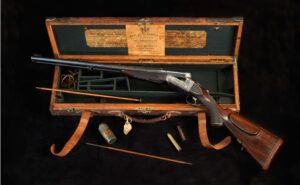
By Jim Dickson
Contributing Editor
When dangerous game is afoot the guns need to match the threat.
In North America you can get by quite nicely on much less powerful choices than those needed for the biggest African and Asian game. Calibers like .50-70, .45-70 and .405 Winchester perform splendidly as does the old .50-100-450 on the biggest game North America has to offer. You can still buy new rifles for the first three of these calibers.
In more modern times the .30-06 has racked up an impressive list of clean kills. Many Alaskan brown bear guides recommend this caliber with 180-grain bullets for their clients because a bear shot through the lungs with one of these means a skinning job for the guide and he doesn’t have to worry about the client flubbing the shot because of a recoil induced flinch. That is not to say that one should not use something larger, just make sure you practice enough with it to insure that you don’t flinch. A flinch on the target range just means losing a match. A flinch on dangerous game can mean losing your life.
That said the .338 Winchester Magnum and the .375 H&H Magnum with 300-grain bullets have proved very popular among those hunting our big bears ever since they first came out. I find it interesting that old sourdoughs who have used them both rate the .375 H&H with the 300-grain bullet and the .45-70 with the 405-grain bullet equal in stopping power on moose and bear.
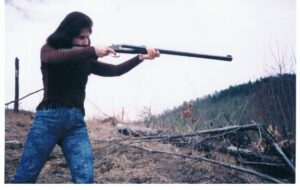
Do not let recoil make you choose a caliber that is too small to get the job done. Just because it will kill big game does not mean it is a suitable choice. I know of one elephant killed with a .22 LR pistol and at least two grizzly bears killed with Luger pistols but I am sure not ever planning on trying to duplicate those feats.
Sometimes people ask if the .270 Winchester is a good bear rifle. Only if I am the beneficiary of their life insurance policy. Do not go under .30 caliber, and the 8MM Mauser with the powerful European loads and 196-grain bullets is even better. Just do not use the wimpy 8MM Mauser loads the American ammunition companies make. These are intended to be safe in the Commission 1888 rifle with its smaller .318 bore instead of the later .323 bore size used in both world wars.
Sometimes you need things to stop NOW! In parts of Canada where you cannot kill a grizzly that claims your moose kill, the bears have learned to come to the sound of a gunshot followed by a mortally wounded moose crashing through the brush before he piles up dead. The solution of some of the moose hunters has been to buy old 8-gauge double barrel elephant rifles and shoot their moose with these cannons. It puts the moose down pronto without any dying rush through the brush that rings the grizzly bear’s dinner bell. It works equally fast on charging grizzly bears in the alder thickets.
The .416 Rigby and .458 Winchester also have their following among those pursuing bear, moose, and bison but these are not as common as they should perhaps be.
For those confining their shots to within 100 yards (always a very good idea on really dangerous stuff) the 12-gauge German Brenneke slugs hit hard and work great. These are used by the Alaskan State Patrol and DNR on problem bears. The Brenneke slug has a long and illustrious history and has successfully taken all the big game on the planet and that includes a fair share of African and Asian elephants. Do not try to substitute the American Flobert pattern slugs as these were intended for deer not dangerous game.
When we get to Africa the game gets tougher and harder to put down. Forget the bad advice of “Choose the gun you can shoot best with.” You are going to have to learn to handle recoil and if you cannot master the proper gun then don’t go.
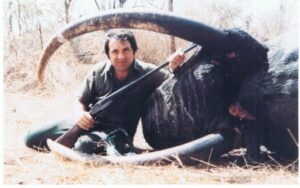
For many places the minimum caliber for dangerous game was the .450-400 Nitro Express with 400-grain bullets at 2,150 FPS. It should be noted that this was the most successful attempt to make a plains game meat getter gun that could also take on the big stuff in a pinch. That last part is important as none of the .40 caliber big game guns have proved reliable at stopping a cape buffalo charge and an elephant that is shot in the shoulder with one of these can sometimes travel far enough to die in an area where it is not legal to shoot elephants. In today’s Africa you have big trouble then.
The .405 Winchester, so beloved by Teddy Roosevelt, made a fine African plains game meat getter and was the favorite arm of the American professional hunter of the first part of the 20th Century, Charles Cotter. Charles guided a friend of mine, Edison Marshall, in those days and Edison related how Charles was killed by a charging rhino that the little .405 could not stop in time. Cotter’s daughter said that her father would have lived through that encounter if only he had used his .470 Nitro Express. The problem was that Charles was an American Western frontiersman who had relocated to Africa and taken his Western love of the lever action rifles he grew up with along with him. A 300-grain .40 caliber bullet at 2,000 FPS is just not medicine enough for the big boys in Africa and a lot of people tried unsuccessfully to tell him that over the years.
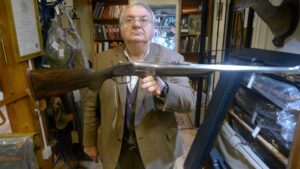
If you are going to shoot dangerous game in Africa, you really need to invest in a Best Quality double rifle that is stocked by the gunmaker to your measurements so that you can throw it up and fire the moment it is cheeked and still be sure of hitting your target out to 100 yards when there is no time or not enough light to use the sights.
Remember that sooner or later everything made by man will break. A double rifle is two single shot rifles in one action and that second barrel is your life insurance policy. African professional hunters in the old days would wear out the barrels of their doubles shooting big game and the chance of their breaking a firing pin or having a misfire with no time to work a bolt and chamber another round made having a Best Quality double rifle a life and death matter.
For African dangerous game you should not use anything that will not put an elephant down promptly with a shoulder shot. (Editor’s Note: TGM checked and a handful of countries in Africa currently allow elephant hunting.)
This is a good standard regardless of what you are after. The .450 Rigby, .500/450 Nitro Express, .465 H&H Magnum, .470 Nitro Express, and .475 Nitro Express are all basically the same power and all offer the same basic performance. A gun for these calibers should weigh a minimum of 11 pounds for acceptable recoil levels and 12 pounds is better. In recent years there has been a tendency to make these guns lighter which adds to the recoil too much. Excess recoil also slows down the second shot and that fast second shot is one of the double rifle’s reasons for existence. You slow it down in a tight spot at the peril to your life.
One of the problems with bolt-action elephant rifles is they weigh a whole lot less than 10 pounds and thus kick much harder than they should. They also have a longer overall length for the same length barrel than a double rifle and they are painfully slow to operate when something that outweighs you by several tons is about to crash into you and you need it to stop in its tracks NOW! That is when the quicker recovery from recoil that the heavier double rifle has and the instant availability of that second shot can make the difference between life and death.
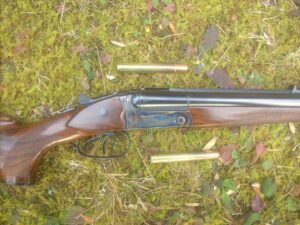
The aforementioned calibers are all ones that anyone can master if they practice. There is a saying in the British gun trade that “Anyone that can shoot a 12-gauge shotgun can handle a .470!” That is basically true despite the fact that at 70 foot pounds (the generally accepted figure in the gun trade of the number of foot pounds of free recoil in a 10 pound .470 rifle) the .470 has considerably more recoil than a 12 gauge. Practice until you can handle it or don’t go on safari.
It is not uncommon to want more power and the .500 Nitro Express with a 570-grain bullet at 2,150 FPS delivers a noticeable gain in power and recoil. A double for this caliber should weigh a minimum of 12 pounds and 14 is better. A few years ago I had to fire 160 rounds in a short span of time through a very underweight .500 double. That gun kicked worse than a 14 pound .577 three inch Nitro Express and it cured me of ever wanting anything to do with underweight guns again.
Some years ago there was a 7-pound .500 Nitro Express offered for sale with 18 cartridges. The next month it was offered for sale again by a different owner with 17 rounds. This continued for several months with a new owner each month and there being one less cartridge offered with it. Finally, I heard through the gun trade that someone had bought it and sent it to the trade to have sufficient weight added to it to make it shootable.
Finally, we come to my all-time favorite big game caliber, the .577 three inch Nitro Express. This cannon fires a 750-grain bullet at 2,150 FPS. It has 100 foot pounds of free recoil. The recoil is tolerable in a 15-pound rifle, bearable in a 14-pound rifle. It starts to hurt in a 13-pound rifle, and below that weight I don’t want to fire it. I recently saw a 10-pound gun in this caliber offered for sale. That’s ridiculous.
While the previous calibers perform just as you would expect an elephant rifle to, the .577 crosses a power threshold and behaves more like the cannon it is. Stories of its true power are reserved for telling among experienced .577 users unless the teller wants to be called a liar or a lunatic.
While the traditional British ammunition has been known to have its bullets deform on elephants the rounds loaded by Wolfgang Romey in Petershagen, Germany using Woodleigh solids has an unblemished track record of completely penetrating the elephant regardless of the angle of the shot.
The .600 Nitro Express was designed with a blunt bullet that would not deflect on an elephant’s temple bone. It lacks the penetration needed for certain angles on elephants and suffered from bad bullets right after WW2 which ruined its reputation. A 900 grain bullet at 1,850 FPS it is usually built as a heavier gun than the .577 and thus often kicks less. Blaney Percival was famous in old Africa for shooting everything with his .600 double. Asked why, he would tell you “Because game shot with a .600 doesn’t go far.”
That brings us to the best piece of advice on dangerous game guns ever given. An old Scottish hunter famously said “Use your big gun for everything laddie and count it practice for the day your life depends on it!”



